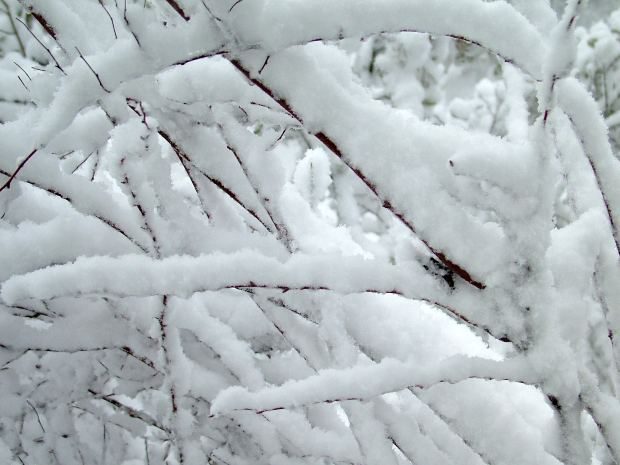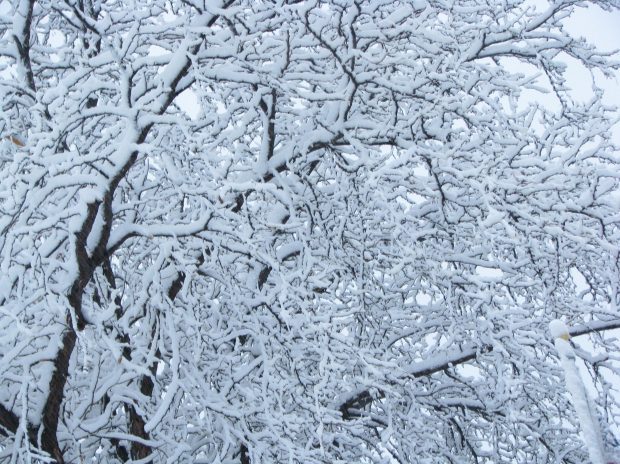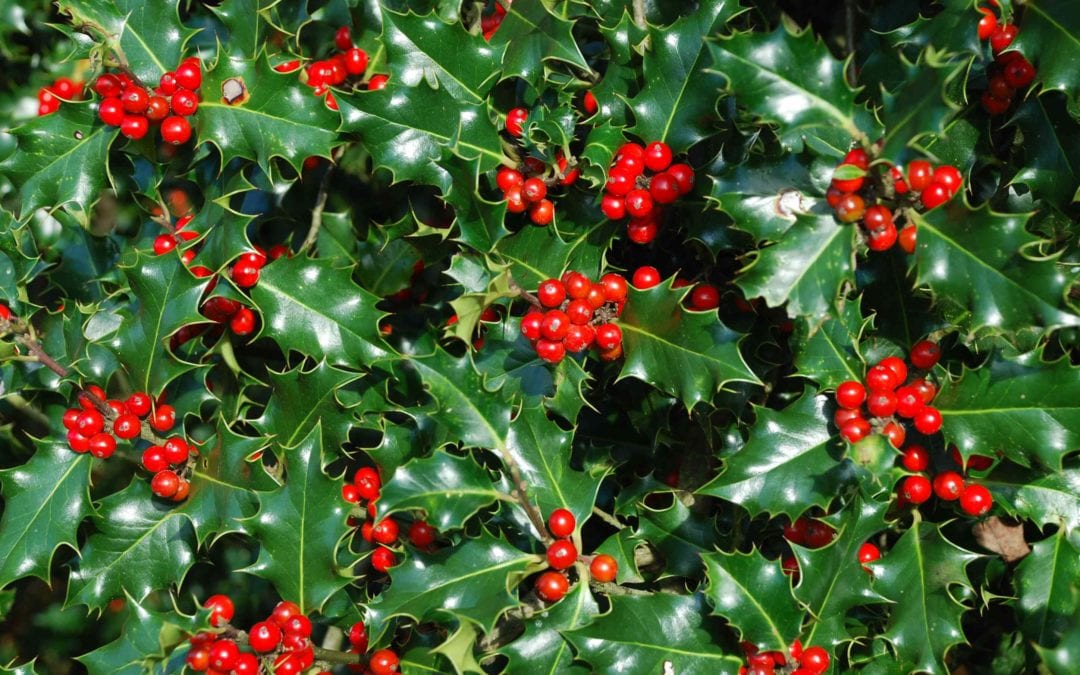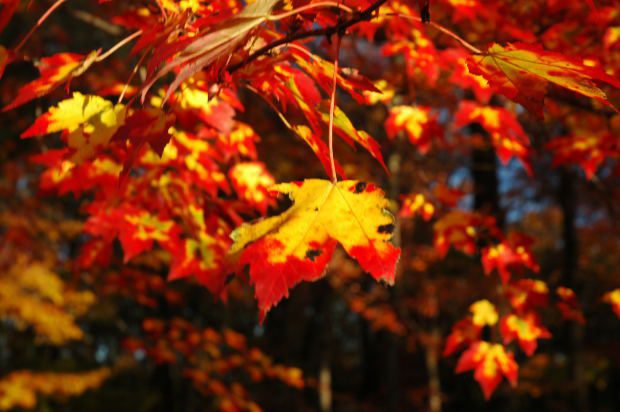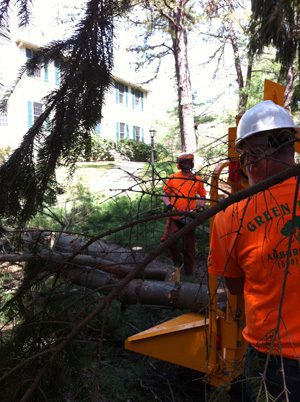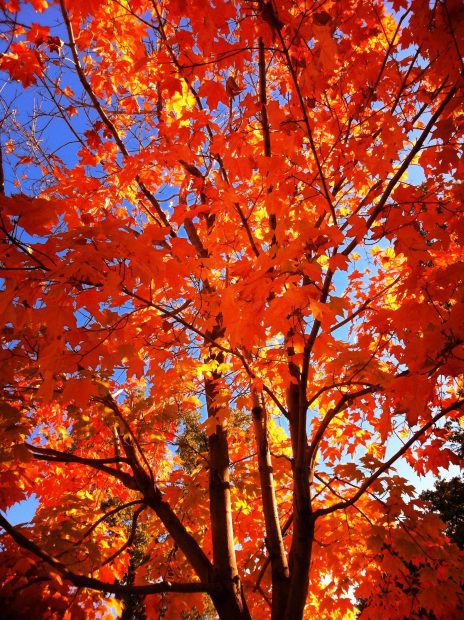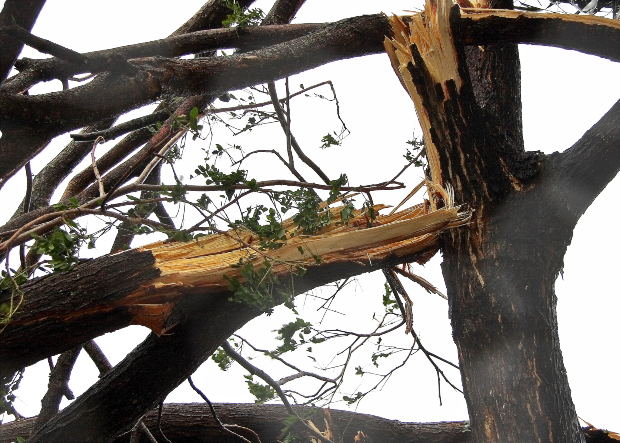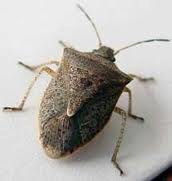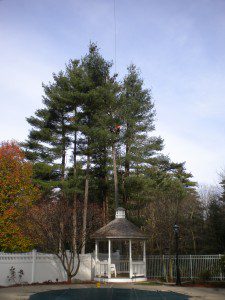
by helper | Jan 5, 2017 | Severe Weather Tree Care, Tree Care
Meteorologists are predicting tonight’s blizzard to be “historic.” While it is smart to make the trip to the store to stock up on groceries and supplies, there are other precautions to consider before a large snowstorm hits. Blizzard tree preparation can be crucial in preventing severe damage to trees as well as creating a safer space around your property.
A blizzard is the strongest and most dangerous type of winter storm. Blizzards bring large amounts of snow combined with extremely powerful winds that create blinding snow, deep snowdrifts, and dangerously low temperatures due to the wind chill.
Heavy, wet snow combined with strong winds can wreak havoc on even the most established of trees-which can also pose a threat to the safety of your home and your family. Limbs or even full trees can be knocked down and land on your home or other belongings in the yard. There is also the risk of limbs or trees landing on power lines, causing power outages or dangerous downed live wires. If a limb or tree falls on power lines on your property, please do not try to remove them yourself-contact highly skilled and trained professionals to remove the trees.
Blizzard tree preparation can involve wrapping smaller shrubs and trees in burlap to help shelter them from the strong winds and large amounts of snow. It can also involve hiring a professional tree company to properly prune weak tree limbs that could potentially pose a dangerous threat to your home.
Green Trees Arborcare has a team of trained professionals for all of your blizzard tree preparation needs. We also offer around the clock snow removal services. If this blizzard is going to be as intense as they are saying-please use caution, stay safe, keep warm, and leave the tree care and snow removal to us. Please contact us anytime at: 508-384-2992 or click here to reach us on the web.

by helper | Dec 15, 2016 | Tree Care, Tree Pruning, Winter Plants
Now that winter is officially here in New England, it’s easy to think that there isn’t much that needs to be done in terms of caring for your trees. On the contrary; winter tree care can be extremely vital in the overall health of the tree for the upcoming warmer months.
Right now, your trees are in the inactive, or dormant, stage of growth-which is the best time to prune. Pruning can be done for aesthetic purposes, but it can also be done for the safety of the tree and your property. If tree limbs are too large and loom near power lines, your home, or other objects on your property-it can put them all at serious risk of damage. Limbs that are too weak need to be pruned to avoid damage to the tree itself. Proper pruning can help to prevent trees from weeping over from the weight of heavy snow and ice that can form in the winter. Pruning in the winter is less intrusive to the tree and is also more effective for the arborist. Due to the lack of leaves, the arborist can easily see the shape of the tree, allowing him to know exactly where to make the proper cuts.
In preparation for next year’s winter tree care, it is helpful to water and mulch some of your trees before the first heavy frost. The mulch will help to retain some moisture in the roots of the tree and help to keep pesky weeds out. Ideally mulch should be spread to about 2 to 3 inches thick using the taper method. Too much mulch piled up next to the trunk of the tree can trap too much moisture which can cause fungus growth and disease.
If there is a large winter storm headed your way and you are concerned about some of the trees on your property, it is best to reach out to a professional who can assess the situation and implement the proper techniques.
Here at Green Trees Arborcare, we know trees. We have a highly skilled and professional team with the right equipment to get the job done right. If you have any winter tree care questions or concerns, please do not hesitate to contact us at: 508-384-2992 or click here to reach us on the web.

by helper | Dec 8, 2016 | Winter Plants
Fall’s beautiful foliage has come and gone-leaving most properties looking gray, dull, and uninviting, but this doesn’t have to always be the case. There are several winter plants that you can place around your property to create a visually pleasing scene throughout the long, cold New England winter months.
Several winter plants offer year-round benefits because many are evergreens. Evergreens will provide your property with a vibrant green color rather than a plant that loses all leaves and flowers-leaving nothing but sparse gray and brown branches. Evergreens are a great addition to the front of a home to cover the foundation-serving not only an aesthetic purpose, but also creating insulation. The foundation will stay cooler in the hot summer months and will serve as a barrier against the cold bitter winds in the winter.
The following are some common winter plants that can be found here in New England:
- Ornamental Grasses-add interest to any property with several different varieties to choose from.
- Winterberry-the “Winter Red” and “Sparkleberry” varieties provide striking red berries that will be striking in a winter scene.
- Blue Holly-probably one of the most quintessential winter plants with its evergreen leaves and bright red berries. Great along walkways or in front of the foundation. Use clippings to decorate inside your home during the holidays!
- Firethorn-the “Yukon Belle” variety is an evergreen and a member of the rose family. It has bright orange fruit that lasts through the fall and winter and has small white flowers in the spring.
- Yew Shrubs-There are several different varieties to choose from and are drought-resistant evergreens that are great in front of a foundation.
- Cypress-These evergreens are well adapted to the New England climate and make for great decorations during the holidays.
- Birch Trees-Several varieties to choose from-most with interesting bark that is a show-stopper year-round.
- Red Osier Dogwoods-A few different varieties to choose from and have stems that range from yellow to red in the winter.
If you are looking to add a pop of color and interest to your property in the winter-consider some of these winter plants. If you are fortunate enough to have some on your property already and have any questions on caring for them, please don’t hesitate to contact us at: 508-384-2992 or click here to reach us on the web.

by helper | Oct 21, 2016 | Tree Care
Fall is synonymous with leaves dropping and trees looking like they have shut down for the winter-while this is true, the fall is actually a great time for planting new trees and shrubs.
While the parts of the tree that are visible above ground are shutting down; what’s below the surface is actually just getting started for the year. Plants develop more roots in the fall than during any other time of year. By planting new trees or shrubs during the fall, you are allowing them to really establish strong roots which gives the plant a healthy head start for next year. As spring approaches, the plant is able to concentrate more on flowering and sprouting new leaves rather than trying to establish new roots. The fall also creates a less stressful environment for newly planted trees with cooler months and typically a decent amount of rainfall.
The following is a list of trees, shrubs, plants, and flowers that are great to plant in the fall:
- A new lawn
- Bulbs that flower in the spring
- Perennials
- Most trees
- Most shrubs
- Evergreens
- Mums
- Asters
- Cabbage
- Vines
If you are looking to transplant any of your existing trees, shrubs, or flowers; fall is yet again the perfect time of year to do so for all of the same reasons mentioned above.
Just because the cooler months are among us doesn’t mean you have to put away your gardening supplies and have a baron looking yard. Roll up your sleeves and keep at it to create an abundance of charm that you can enjoy year-round.
If you have any tree care or new trees questions please don’t hesitate to contact Green Trees Arborcare at: 508-384-2992 or click here to reach us on the web. Green Trees Arborcare takes pride in excellent customer service and our passion for tree care.

by helper | Sep 12, 2014 | Tree Care
Tree trimming and tree pruning are both crucial for the health and structure of beautiful trees that you have invested significant time and money into over the years. Although both procedures sound very similar, which in some ways they are; they are each done for different reasons.
Tree trimming is available to residential and commercial properties and can be done any time of the year as needed. Large and small trees can be trimmed if it will improve the overall health of the tree. Tree trimming is typically done when: trees become too large, pose a threat to your property or a neighbor’s property, grow to close to power lines, or when limbs become too weak to withstand extreme weather.
Tree pruning is a delicate procedure that is done strategically at certain times of the year for the overall health and structure of a tree. Like tree trimming; tree pruning is great for both residential and commercial properties. The best time to properly prune a tree is when it is dormant-doing so promotes better health and prevents excessive sap loss. Pruning enhances the shape of a tree, creating more pleasant aesthetics and a healthier structure. Proper pruning helps prevent tree diseases by increasing air flow and promoting strong growth which resists damages.
If you believe that trees on your residential or commercial property are in need of professional tree trimming and tree pruning, a member of our team would be more than happy to provide you with an estimate.
If you have any questions regarding tree trimming and tree pruning, please don’t hesitate to contact us at: 508-384-2992 or click here to reach us on the web. Green Trees Arborcare takes pride in excellent customer service and our passion for tree care.

by helper | Aug 28, 2014 | Tree Care
As summer begins to come to an end, it is a good time to start thinking about fall tree care. The stunning New England autumn foliage will be here before we know it and while the hotter months may be behind us, there are still ways to properly care for the trees on your property.
The following are some helpful fall tree care tips to consider over the next few months:
- Avoid pruning in the fall. Fall is the time of year where fungus spreads rapidly and cuts on trees take longer to heal. Unless tree branches are dead or diseased, put down the pruning shears.
- Fall can be a great time to plant new trees. The temperatures will be a bit cooler and won’t create as much stress as some of the summer months. Less stress on a tree allows for a stronger root system to develop.
- If planting new trees in the fall, be sure to properly water them. A long and deep watering helps the roots to grow downwards, making them stronger; whereas a short and shallow watering creates roots that grow upwards and end up becoming weak.
- For more mature trees: stop watering at the beginning of fall and allow all of the leaves to drop. Once the leaves have dropped, begin watering again until the first freeze so that the roots have enough water to last throughout the winter drought.
- If planting new trees in the fall, remember that here in New England, our winters can be very cold and harsh. A good way to protect young trees is by laying 3-6 inches of mulch at the base of the tree after the first freeze. Avoid placing the mulch right up against the trunk to avoid moisture getting trapped and creating fungus growth.
If you have any questions regarding fall tree care, please don’t hesitate to contact Green Trees Arborcare at: 508-384-2992 or click here to reach us on the web. We are more than happy to assist you in the health of your trees!

by helper | Aug 21, 2014 | Diseased Trees
The life cycle of a tree is a beautiful thing, especially here in the Northeast. However, a diseased tree can be an eyesore and a potential threat to your property.
The typical life of a healthy, leaf-bearing deciduous tree includes: sprouting in the spring, leaves turning brilliant colors of red, orange, and yellow in the fall, drying out and leaves falling off in the winter, and the tree coming back to life again come springtime.
Trees have the ability to adapt to and withstand harsh conditions, such as extreme weather patterns here in New England. However, it is not uncommon for a tree to become diseased. The tree will do its best to try to fight the disease, but even the oldest and sturdiest trees can lose the battle. Once a tree becomes weakened by one disease, like humans; it can become more susceptible to other diseases.
Anthracnose is a common disease in the eastern part of the United States that goes after hardwood trees, particularly American sycamores, white oaks, dogwoods and black walnuts. Root decay/root rot is another common disease for trees. The roots securely anchor a tree in the ground therefore if a tree has rotten roots; it makes the tree vulnerable to harsh conditions and runs the risk of being knocked over.
There is a difference between an unhealthy tree and dead or dying trees. An unhealthy tree can be caused by the elements such as rain, wind, and sun and often bounce back to health. A diseased tree often has the following telltale signs:
- Decay. Decay can begin from the inside of the tree, making it difficult to notice. However, if there is fungi or soft, crumbly wood present, that is a good indicator that there is decay in the tree.
- Weak branch unions.
- Cracks that create deep splits through the bark.
- Dead wood. Dry, lifeless wood that breaks easily does not allow a tree to bend in the wind. A tree in this condition should be removed immediately because it poses a large threat to your property.
- Uneven growth pattern from years of storms or improper pruning.
A diseased tree can pose a serious threat to you, your family, and your property. If you suspect signs of disease, please contact Green Trees Arborcare for information on pruning, tree care, and tree removal. Safety is always our number one priority. We can be reached at: 508-384-2992 or click here to reach us on the web.

by helper | Jul 3, 2014 | Severe Weather Tree Care
With Hurricane/Tropical Storm Arthur currently making his way up the Eastern coast and putting a damper on 4th of July plans, now is a good time to address proper hurricane tree care. Hurricane season typically lasts from June 1-November 30. The best way to prepare trees for hurricanes is from the very beginning before you start planting. While Massachusetts has been known to have a few significant hurricanes pass through, it is nothing compared to states like Florida and North Carolina. However, if tree damage is a concern of yours when a hurricane or tropical storm does makes its way through the state, here are a few hurricane tree care tips to keep in mind:
- Work with a tree care professional or landscaper to carefully choose trees that are a good option for strong winds and heavy rains.
- Choosing trees with strong root systems, trunks, and branches is the best option.
- There are certain species of trees that are more wind-resistant than others.
- Plant trees away from the house and power lines.
- Once trees have established themselves, contact a professional tree company to properly prune your trees.
- Proper pruning will encourage the development of a sturdy, well-spaced framework of healthy branches around a central leader. The canopy edge can be thinned, allowing air to pass through freely.
- If you feel like there are trees on your property that should be removed because they are already dead, weak, or rotting and fear damage to your property, contact a tree care professional to come out and assess the situation.
Hopefully these hurricane tree care tips will provide some insight before the upcoming storm and the remainder of the 2014 hurricane season.
Here at Green Trees Arborcare, we understand how important trees are but also comprehend the potential dangers they pose to your property when in-climate weather hits. If you need to have any of the trees on your property assessed before taking further action or simply need well-established trees properly pruned, please don’t hesitate to contact us at: 508-384-2992 or click here to reach us on the web.

by helper | Jun 9, 2014 | Tree Pests
Tree pests are a constant-growing issue in the United States. Each year new and invasive species get introduced to different parts of the country and the results can be devastating. Massachusetts and other parts of the Eastern United States has quite a few pests that are common in the area. The Gypsy Moth is one of the most common pests to hardwood trees. Since 1980, the gypsy moth has defoliated close to a million or more forested acres each year. In 1981, a record 12.9 million acres were defoliated. This is an area larger than Rhode Island, Massachusetts, and Connecticut combined (source: About.com-Forestry).
Other common tree pests in Massachusetts include:
- Winter Moth. This moth is known to destroy oaks, maples, basswood, white elm, crab-apple, apple, blueberry, and cherry trees. Adult moths emerge in late November and can be active until January. After mating, the female moths lay egg clusters on tree branches and under bark. The larvae will appear in March and tunnel into buds and devour them and then move on to the next bud. The older larvae feed on foliage. In areas where winter moths are a large problem, they are known to completely defoliate the host plant.
- Asian Long-horned Beetle. This beetle feeds on maple, horse chestnut, birch, poplar, willow, and elm trees. The female beetle will chew a dime-sized oval groove into the bark to deposit her eggs. The larvae damage the tree by eating the layer beneath the bark which creates hollow galleries in the wood. A key indicator of an issue with the tree and this beetle is if there is sawdust around the base on the ground or on the branches where the adults have exited from the tree.
- Brown Marmorated Stink Bug. This insect was accidentally imported from Asia and has been creating problems ever since. The insect is a problem for many shade and fruit trees, vegetables, and legumes. Adults emerge in April and eggs are laid in clusters on the under-sides of leaves from June through August. Aside from being pests to trees and plants in the warmer months, this insect can become a huge nuisance to homes and buildings in the winter when they use them as overwintering sites.
There are certain precautions you can take to control tree pests. For questions please don’t hesitate to contact us at: 508-384-2992 or click here to reach us on the web.

by helper | May 8, 2014 | Tree Care
Hot Weather Tree Care Tips
It may feel like we just came out of a long, cold winter and are now finally able to enjoy the spring; but the truth is summer is just around the corner. Most people associate extreme weather in New England with blustery winters, but our summers can be just as extreme. Massachusetts is no stranger to extremely high temperatures and the dreaded humidity. Hot weather tree care is extremely important for newly established trees, but is also just as important for mature trees.
A newly established tree is weaker and more vulnerable if not properly cared for, but mature trees can also die out from a lack of water. Water evaporates from the leaves of a tree and on a hot summer day a tree can lose hundreds of gallons of water. The best way to prevent trees from drying out is with a soaker hose. The soaker hose will encourage your plants to establish a deep, drought-resistant root system. Water the tree long enough to allow the water to reach 8 to 12 inches down into the soil. Covering the tree’s root system with mulch about 3 inches thick will help to retain the moisture as well as reduce the temperature of the ground. If you choose not to use a soaker hose, sprinklers and hand-held hoses can get the job done.
Another hot weather tree care practice to implement is treating for disease, fungus, and insects. If you notice brown spots on the lawn or an abnormal amount of insects hanging around your trees, contact a professional who can treat the effected area properly.
Proper watering and mulching are the two major keys to success for optimal tree and plant health in the hot summer months. Here at Green Trees Arborcare, trees are our passion. We have an extensively trained, professional team that can cater to all of your tree care needs. Please do not hesitate to contact us with questions or for a quote anytime at: 508-384-2992 or click here to reach us on the web.
